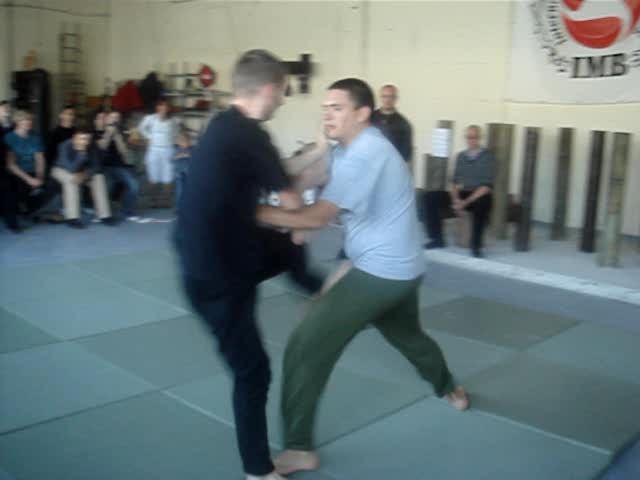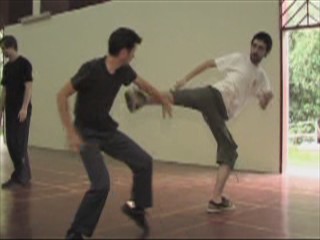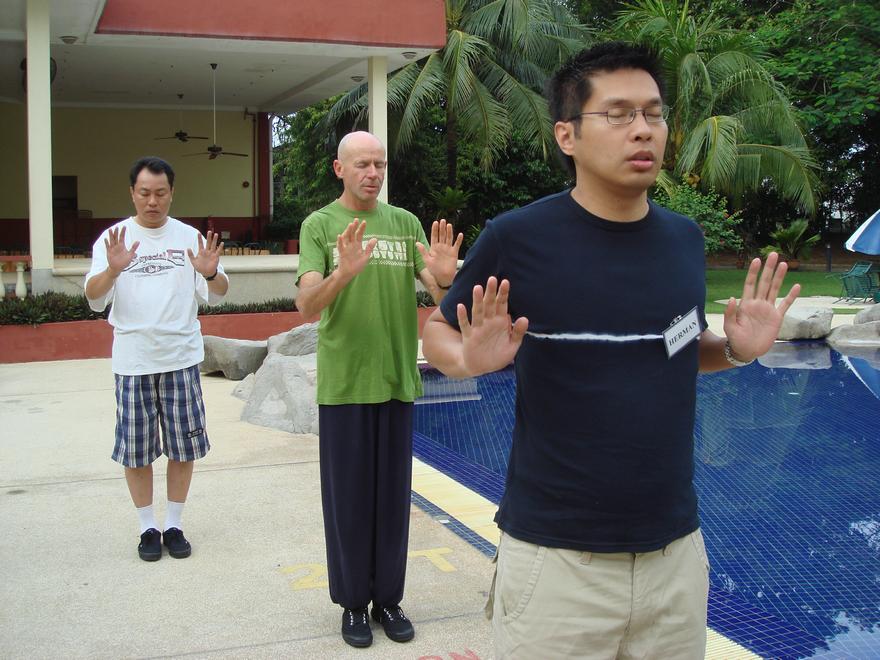SELECTION OF QUESTIONS AND ANSWERS
MAY 2013 PART 1

Being able to face threat is an essential factor in winning free sparring cojmpetitions
Question 1
What should one do to be a successful Shaolin Kung Fu fighter and healer?
— Sifu Lee Wei Joo, Malaysia
Answer
To be successful in any endeavor, one must be good at the art involved and produce the result intended. This is obvious, but many people may not realize what it means, and fewer still achieve desirable result.
Let us relate this guideline to Shaolin Kungfu fighting and healing.
Hence, to be a successful Shaolin Kungfu fighter and healer, one must be good at both the philosophy and practice of Shaolin Kungfu fighting and of healing, and be able to win in combat with yourself being unhurt, and to help patients recover from their illness and attain good health.
However, even when Shaolin practitioners won free sparring competitions, they did not use Shaolin Kungfu in their fighting, and they themselves were hurt. This is against both the philosophy and practice of Shaolin Kungfu.
Even when chi kung healers knew the philosophy and practice of chi kung healing, they had not healed many patients, thus not producing the result intended of their training.
Knowing the guiding principle and mistakes other fighters and healers made as explained above will better enable you to succeed in your endeavor.
Question 2
What are some of my own personal strengths and weaknesses that I have to work on to be a successful Shaolin Kung Fu fighter and healer?
Answer
Different people would need different ways to improve their art and result. The following suggestions are specially meant for your situation.
In your case, you have a good understanding of the philosophy and practice of Shaolin fighting and of healing, and you are not yet producing results. Hence, your focus on becoming a successful Shaolin fighter and healer will be winning free sparring competitions and curing a lot of patients.
The main reason why you have not won free sparring competitions is because you have not participated in any. The main reason of your non-participation is your lack of confidence in winning and your fear of being hurt. And the main reason for this is your lack of experience in fighting against other martial artists where a lot of threat is involved.
Actually you are a better martial artist in both martial art philosophy and practice than most other martial artists, but if you were to fight them now, it is more likely that they beat you than you beating them. Why is it that though you are better in the art, you do not produce the desired result?
The main reason is your lack of fighting with a lot of threat, as mentioned above. Hence, even you are a better fighter, when other martial artists attack you with a lot of threat, you lose your composure and are unable to use your skills and techniques which you can effectively use when sparring without this element of threat amongst Shaolin Wahnam members. This is a major weakness amongst many of our students and some instructors.
Understanding this situation, you will be able to plan your remedial training programme most cost-effectively. You will realize, for example, that for this purpose you need not learn new techniques and skills, though they are useful for other purposes. What you need is to overcome this element of threat. The 30-Opponent programme is excellent for this purpose. The Wuzuquan course is also excellent as course participants will be trained how to face as well as exhibit threat.
Similarly, you are already well trained in philosophy and practice of chi kung healing. What is lacking is producing the intended result. In other words, in both Shaolin fighting and healing, you have done well in the preparation part. What you need is to do well in the implementation part.
As in Shaolin fighting, in healing you have not produced good result because you have not even started working on it. You have thought and talked long enough on how to heal people. Now stop the thinking and talking, and start healing.
There are a lot of sick people who need your healing. Don't just continuously talk about how to reach them. Actually go to them, or make them come to you. There are many ways you can do so. Just choose any one way and act on it. Even if you had chosen the worst method to work on, it is still better than having the best method to talk about.

We should use kungfu patterns in free sparring
Question 3
Despite how far I have come, I still know that I have a long way to go, especially where it concerns my relationship with my family.
Answer
The long way to go is not thinking about or learning theories on family relationship, but actually doing something about it.
There are many things you can do. The important point is not how many things there are, but actually doing it, even if it is only one thing. You can, for example, make it a point to write to your parents once a week, irrespective of whether they reply.
Question 4
I have seen that all of the successful Shaolin Wahnam instructors and members have wonderful relationships with their families, which I somehow know is one of the cornerstones of what makes them successful.
Answer
You are right. Having a happy family, which is a value highly cherished in our school, is the foundation for any success. There is a Chinese (Cantonese) saying, "ka woa man si heng", which means "When the family is harmonious, a million events become prospitious."

Enjoying a happy family life is a cherished value in our school. The picture above shows Rafael with his happy, beautiful family.
Question 5
Conversely, my relationship with my family has been constrained, and I'll honestly say that my siblings and I act and behave like strangers. I do realize how much my parents love me, but I feel that without a solid foundation with my whole family, I cannot become a full, realized Shaolin Wahnam kungfu instructor, scholar-warrior and healer.
Answer
Knowing a problem is the first, important step. The next step is to act on improving the relationship.
If you choose a good step, the improvement is fast. If you choose a poor step, the improvement is slow.
Even if you had chosen a poor step, there will still be improvement. It is certainly better than merely thinking about the problem but never acting on it.
A good step is to employ the three factors of karma taught by the Buddha, namely thought, speech and action. Always have good thoughts about your parents and siblings, speak to and about them in a positive way, and perform actions that will improve your relationships. You will be surprised how fast the relationships will improve
Question 6
As they are now practically living in the United States, I foresee that someday I will eventually move there to be closer with them. I have only seen them perhaps twice in 6 years.
Answer
Staying with them and improving your relationship with them are two different issues. If your relationship is bad, staying with them together would make the situation worse.
On the other hand, you can have an excellent relationship with your parents even when you live far from them. This does not necessarily mean that you should not be with them, but you need to see they are different issues.
Editorial Note
: Sifu Lee Wei Joo's questions will be continued at
May 2013 Part 2
issue of the Question-answer Series.

Students performing Pushing Mountain at an Intensive Chi Kung Course
Question 7
Earlier after Pushing Mountain you asked as to let go and go into vigorous chi flow. But just now you asked us to keep fairly still. When do we go into vigorous chi flow and when do we keep fairly still?
— Malta, Holland
Answer
When we want to circulate our energy, we go into vigorous chi flow. When we want to consolidate energy into internal force, we keep fairly still.
This is relative, a matter of emphasis. When we go into vigorous chi flow, we also develop internal force, but if all other factors were equal, the internal force is not as powerful had we kept fairly still. On the other hand, when we keep fairly still, we also circulate our chi, but the circulation is not as powerful had we entered a vigorous chi flow.
The techniques and results mentioned here apply not just to Pushing Mountain; they apply to all chi kung exercises, though certain exercises are more suitable for circulating or for building.
If all other factors were equal, Self-Manifested Chi Movement is about 90% circulation and 10% building, whereas at the other end Sinew Metamorphosis is about 10% circulation and 90% building. Eighteen Lohan Hands are about 50% circulation and 50% building.
If we are skilful, by choosing to go into vigorous chi flow or remaining fairly still, as well as using our mind, we may vary the proportion of circulation and building. We may, for example, perform an exercise for Sinew Metamorphosis and go into vigorous chi flow to have 90% circulation and 10% building.
Because the default proportion in Eighteen Lohan Hands is 50-50, it is the easiest for such manipulation. We can perform any exercise from the Eighteen Lohan Hands and use it for circulation or building in any proportion.
Question 8
Sigung, when Bina asked me what she should do to overcome her fear of free sparring with martial artists of other schools, I told her, "Just do it", like what you had often said. Why is this advice not suitable in this case?
— Sifu Andrea, Switzerland
Answer
The advice, "Just do it", is excellent for students to perform some tasks where they have the skills and confidence to do, like how to relax or acting on a decision made. Their problem is not a lack of confidence, but hesitation and intellectualization.
For example, when students intellectualize on how they should relax, we push them into immediate action by commanding them to just relax.
It is like someone intellectualizing on how to walk, whether he should first put his right leg or left leg forward, and whether his toes or his heel should land on the ground in front. By telling them to just do it, we command them not to intellectualize and just walk.
A student has decided to practice "Pushing Mountain". Then he hesitates and intellectualizes whether he should practice "Carrying the Moon" instead. He debates whether "Pushing Mountain" or "Carrying the Moon" will give him more benefit. He wonders whether he could perform "Pushing Mountain" as well as “Carrying the Moon” or another exercise.
So we tell him to just do it. Just practice "Pushing Mountain" and stop worrying about whether other exercises are better. The fact is that there won't be much difference regardless of which exercise he practices. But if he hesitates to practice and start worrying and intellectualizing instead, not only he will have no benefit but he may also derive harm.
Bina's case is different. It is not a matter of hesitation or intellectualization. It is a case of a lack of confidence. If we advice her to just do it, and she follows our advice, it will aggravate her fear of free sparring with other martial artists.
So, what should we do? We should strike at her problem. We should overcome her fear and restore her confidence.
This can be accomplished in a threefold approach, namely explanation, examples and demonstration.
We explain to her that she will not be hurt at all because she has the necessary force, skills and techniques to handle appropriate opponents in free sparring.
To make this double sure, she should choose opponents who are below her level of combat efficiency to start with. She will find it easy to defeat these opponents because they are below her level. As she gains skills and confidence, gradually she progress to fighting more skilful opponents.
Then we give examples of students at her level of combat efficiency who spar with other martial artists and are not hurt. This will give her assurance.
Thirdly we arrange for some students to spar with her. These students vary in the level of combat efficiency, starting with a level below Bina gradually progressing to a level above her.
If we can have friends from other martial art schools to spar with her, it is even better. If friendly sparring partners are not available, we ourselves can spar with her, adjusting our level according to her progress.
If Bina follows this programme, she will overcome her fear and be able to spar competently with other marital artists.
LINKS
Selected Reading
- Shaolin Eighteen Lohan Hands
- The Aggressive, the External and the Internal
- Thank You
- A Gift of Chi
- Learning Shaolin Sparring in Three Days!
